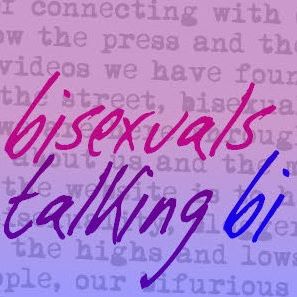Had more sex with cis-men than any other gender..?
How Suppressing Unwanted Sexual Desire Impacts Bisexual Health
How Suppressing Unwanted Sexual Desire Impacts Bisexual Health
My Harmful Heteronormative Education
Eight reasons why more women in the UK are having same-sex than they were 20 years ago
  |
| Women in the 1990s: less likely to have sex with other women |
  |
| Lesbian power couple: Alice Arnold (left) and Clare Balding |
But to be fair, I think it is also true that some parts of the lesbian community, anyway, are more tolerant towards women who aren't 150% lesbian, though understandably perhaps not towards women who are "experimenting".
  |
| Katy Perry |
Hysterectomy: a beginning
I almost forgot:
I no longer have a womb.
When I come crying out hard;
Swearing “Fuck!” to the ceiling,
My cunt tightens, implodes under my fingers.
The space where my womb used to be
Becomes a vacuum.
Nature may hate it, but I don’t.
For every time I come I feel a spark:
A flicker of life in my innermost parts.
Something is growing. Something moves.
I squeeze my eyes shut. I imagine a bloom
Of pure energy.
Drawn out of pleasure,
A hopeful alien life reaches out.
A concept that nobody spoke of,
Until they took my cervix and my womb
To save my life;
To give me something new.
*
*
*
Life after a hysterectomy? Yes.
Sexual desire after a hysterectomy? Yes
Mind-altering orgasms after a hysterectomy? Hell Yes!


Double or Nothing


They say the sun shines on the good and bad.
So why can’t I get laid?
I heard bi’s have double the chance of a date.
So why can’t I get laid?
And double of nothing still means squat.
I’m actually quite horny.
***
Women won’t look at a bi girl like me.
When will I ever get laid?
They say, “Pick one side and stick with it.”
But that halves my chances of getting laid.
And half of nothing still means zero.
I’m so very horny.
***
I’ll learn to love straight blokes again.
It’s the only way I’ll ever get laid.
I’ll tout myself out; short skirts, tits out.
That’s guaranteed to get me laid.
But my chest is cold and my skirts are long,
And my horny urges are really not that strong.
And besides, this dry spell’s not half bad.
I’ll stay home with some tea, toast and jam.
Not feel pressured to be a stereotypical bi.
Maybe I’ll remember how to smile.
***
You see it’s the not the end of world,
To be a mildly horny, lonely girl,
Who wants nothing more,
Than to be reasonably sore,
And sticky and rumpled and happy.
And just get laid.
***
When bisexual people are told we must spend all our time having sex with lots of people, it can a) be hurtful if we are also celibate or asexual, and b) leave us open to unwanted sexual advances from others. It’s horrible to get this stereotype pushed on us by monosexual people, but it’s depressing when we start to feel we should be this way ourselves.
Photo: Veggies, Yarns and Tails
Michael Bailey and bisexuality – again
I am not in the UK at the moment. Not, indeed, anywhere with a reliable internet connection, but I read this and thought of you dear followers, regular readers, and people who find this site via Google, Twitter, Sex is Not the Enemy, Bipolar Bisexual,Mark Simpson and other sites that link to me.
It's about Michael Bailey, he who has been so controversial in denying that bi men are really bi.
The piece below (which was posted on the academic bi yahoo group) begs so very many questions - but I thought it interesting to throw it out there and see what you think.
Lots of love and post soon...
Sue x
The Daily Northwestern - NU Prof. Bailey researching possible 'gay
gene'
See piece here
Recent research from Northwestern Prof. J. Michael Bailey raises new questions in the science behind sexual orientation, namely bisexuality and the prototypical "gay gene."
In his studies on bisexuality, Bailey, a psychology professor, and a team of researchers look at sexual arousal patterns to objectively determine sexual orientation in men and women. Bailey tracks the subject's brain activity while they are looking at erotic pictures to essentially determine "what turns them on," he said.
One new finding is in the sexual orientation of women. Bailey said he found most of his female subjects to be scientifically bisexual, even if they subjectively thought otherwise.
"Women don't work in the way we thought, based on a lot of research we did five to 10 years ago," he said. "Women, at least in the laboratory, get aroused to both stimuli."
This changes everything, Bailey said.
"Now I don’t even know if women have something like a sexual orientation," he said.
About two-thirds of women are showing arousal patterns that differ from what they consider to be their orientation, said Adam Safron, a research consultant on the project.
"Women are not being driven in their arousal pattern in the same way as males," he said.
Male arousal patterns were less flexible than female patterns, Bailey said. Men who believed themselves to be bisexual were aroused by both female and male stimuli but exhibited a stronger arousal to males than females. Bailey published a paper in 2005 suggesting bisexual men do not have bisexual arousal patterns. If sexual arousal patterns are the key to sexual orientation and his research is accurate, male bisexuality may not actually exist, Bailey said.
"I never meant to suggest bisexual men were lying about their sexuality," he said. "But there has been some skepticism about if bisexual men are really bisexual in the same way gay men are gay or straight men straight."
Safron said the science behind sexual orientation can get complicated.
"In terms of what people tell you they like, you can't always trust what they tell you, especially with something as emotionally involved as sexuality," he said.
...
Michael Bailey and bisexuality – again
I am not in the UK at the moment. Not, indeed, anywhere with a reliable internet connection, but I read this and thought of you dear followers, regular readers, and people who find this site via Google, Twitter, Sex is Not the Enemy, Bipolar Bisexual,Mark Simpson and other sites that link to me.
It's about Michael Bailey, he who has been so controversial in denying that bi men are really bi.
The piece below (which was posted on the academic bi yahoo group) begs so very many questions - but I thought it interesting to throw it out there and see what you think.
Lots of love and post soon...
Sue x
The Daily Northwestern - NU Prof. Bailey researching possible 'gay
gene'
See piece here
Recent research from Northwestern Prof. J. Michael Bailey raises new questions in the science behind sexual orientation, namely bisexuality and the prototypical "gay gene."
In his studies on bisexuality, Bailey, a psychology professor, and a team of researchers look at sexual arousal patterns to objectively determine sexual orientation in men and women. Bailey tracks the subject's brain activity while they are looking at erotic pictures to essentially determine "what turns them on," he said.
One new finding is in the sexual orientation of women. Bailey said he found most of his female subjects to be scientifically bisexual, even if they subjectively thought otherwise.
"Women don't work in the way we thought, based on a lot of research we did five to 10 years ago," he said. "Women, at least in the laboratory, get aroused to both stimuli."
This changes everything, Bailey said.
"Now I don’t even know if women have something like a sexual orientation," he said.
About two-thirds of women are showing arousal patterns that differ from what they consider to be their orientation, said Adam Safron, a research consultant on the project.
"Women are not being driven in their arousal pattern in the same way as males," he said.
Male arousal patterns were less flexible than female patterns, Bailey said. Men who believed themselves to be bisexual were aroused by both female and male stimuli but exhibited a stronger arousal to males than females. Bailey published a paper in 2005 suggesting bisexual men do not have bisexual arousal patterns. If sexual arousal patterns are the key to sexual orientation and his research is accurate, male bisexuality may not actually exist, Bailey said.
"I never meant to suggest bisexual men were lying about their sexuality," he said. "But there has been some skepticism about if bisexual men are really bisexual in the same way gay men are gay or straight men straight."
Safron said the science behind sexual orientation can get complicated.
"In terms of what people tell you they like, you can't always trust what they tell you, especially with something as emotionally involved as sexuality," he said.
...
